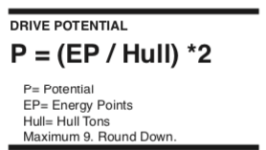For example, you express understanding in my backwardness, which only amuses my sarcastic side:
Then you have completely misunderstood what was being said and why I said it.
Look, I understand there's tradition involved in your reluctance to let go of ingrained patterns of thinking (that have held sway for over 40 years)
Tradition involved?
Yes, obviously.
Ingrained patterns of thinking involved?
Yes.
Duration of those patterns of thinking (in the Traveller context)?
40+ years (going back to 1977 actually).
Reluctance to overturn past precedents?
Plentiful.
Reluctance to embrace a new paradigm?
Clearly.

Also more commonly known as "ain't broke/don't fix" ...
Everything in the statement I made is completely true.
It's also a more universal truth than something unique and specific to this topic.
Politics, religion, loyalty to a sports team or to celebrities, technological innovation ... take your pick ... when there's tradition involved in an ingrained pattern of thinking that has held sway for a long period of time, there's going to be a reluctance among people to overthrow a past paradigm in favor of embracing a new one.
For more egregious manifestations of this phenomenon, there's issue of
Paradigm Paralysis which goes beyond reluctance.
Perhaps the greatest barrier to a paradigm shift, in some cases, is the reality of paradigm paralysis: the inability or refusal to see beyond the current models of thinking.
My point was that if you're going to "overhaul the paradigm" of primary mission codes like you explicitly stated was the purpose of the exercise in your OP ... you might as well "do a proper job of it" and do a wholesale reexamination of the primary codes and what they are meant to be used FOR. What information are those mission codes intended to convey? Which ones can be combined to streamline the system?
If you're going to scrape off the barnacles and cruft that's built up over time ... then go ahead and scrape off the barnacles and cruft to get to a sleeker paradigm for how to think about these things that will be cleaner to work with moving forward.
When you start from the position of wanting to "overhaul the paradigm" of primary mission codes, it's a bit rich to say that half a dozen redundant commercial codes need to be retained because ... tradition/reasons ... when two of them are literally A-Merchant and M-Merchant.
There is only the Starship, and the Nonstarship, and the small craft.
I disagree.
The starting point is the roles of civilian, paramilitary and military.
Everything else is a further refinement of those categories from there.
A lot of primary mission codes apply exclusively to a single starting role (like military battleship, for example) while others can have multiple (like civilian, paramilitary and military hospital craft).
There can be civilian Tenders (for L-Hyd drop tank services, for example).
There can be paramilitary Tenders (the Express Boat Tender would be an example of this).
There can be military Tenders (usually for Battle Riders).
The demands of each environment and operational use case winds up being quite different, leading to a variety of different designs ... but they're still all Tenders (in this example). Whether the best design to fulfill those requirements is a starship, nonstarship or small craft is substantially immaterial to the primary code that ought to be used for craft used to perform those functions. Different craft "fit" different primary codes differently.
Then let's argue your point to absurdity, because its logical conclusion is to conflate all starships into one design
When your explicitly stated goal is achieve absurdity ... the danger isn't that you'll find it, but that you'll look ridiculous when you do because of what you had to do to achieve your stated goal.
And to be clear beyond doubt, I wasn't attempting to conflate all craft into one design.
Only you attempted to do that ... on your own ... without prompting ... in search of absurdity.
Congratulations, you found your own absurdity, just like you
threatened promised.
Why are you annoyed at being called on it when you were so proud of the "logic" of your discovery?
Your turn.

